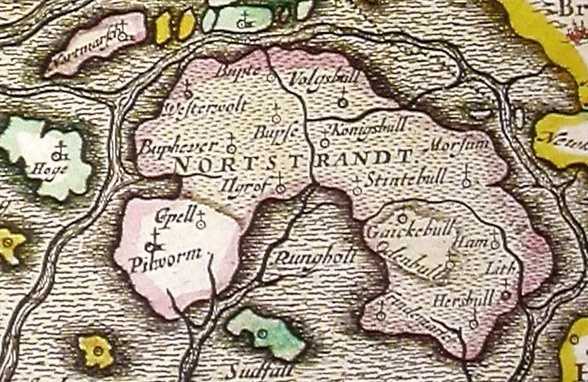The Great Drowning of Man
/By Olaf Kanter, translated by Marcel Krueger:
An excerpt from the novella “Eine Halligfahrt” (A Trip to the Hallig) by Theodor Storm, published in 1871, tells the great North Frisian drama: the city of Rungholt, located on the island of Strand in the North Frisian wadden sea, was devastated by a flood in 1326 and torn away by the breakers together with the ground it was built on. Storm moved the narrative into a moral cosmos, wherein God's will is the strongest force. The inhabitants of said island were, according to Storm, drunk on their wealth, and refused the forces of nature the respect these deserve; they even mock the sea. During storms they climbed up the dykes and shouted into the surf: “Trutz nu, blanke Hans!”, which could roughly be translated as “Do your worst, you poor fellow!” This worked well up until the day the islanders made a pig drunk and called a priest to give the last rites to the poor creature. This was one disrespect too many, and this blaspheming could not be allowed to continue. God sent a massive flood, and Rungholt drowned with man and mouse. So far the legend.
Reality, as reconstructed by historians and scientists centuries later, was no less cruel.
The last ice age had pushed a bow wave of stones and sand ahead of it from Scandinavia. This moraine of "boulder clay" became the foundation of the big geest islands in the North Frisian wadden sea, of Sylt, Amrum and Föhr. As the water levels rose, protected waters were formed behind the islands where sediment was deposited. An extended marsh was created, and as the first humans settled here, one could walk to Sylt dry footed during low tide; only a few small tideways needed crossing. Sylt wasn't an island proper back then but west coast - the west coast of a landmass we call Schleswig-Holstein today.
The inhabitants of Rungholt had the bad luck of settling behind the geest islands of Sylt, Amrum and Föhr on a ground consisting of loose deposits - gravel, sand and peat. And the compacting of these loose ground in the alluvial lands were not by a long shot completed yet, it kept subsiding. The islanders would have needed to constantly raise their dykes to compensate for the sinking of their ground - which they didn't do. They actually did the opposite: they kept digging into the ground behind the dykes and harvested peat to mine salt from it in an elaborate process. One of the reasons for the relative wealth of the region - and at the same time its doom.
Then the big flood came. Storm from the west whipped the water in front of it, and on January 16, 1362, the dykes broke all across the North Sea coast. First the land around Rungholt filled like a bath tub, and then the sea just washed away the loose ground beneath the city. Rungholt sank into the North Sea, literally, and there are no indications for survivors in the contemporary chronicles. Today no one can really say how many people died in this catastrophe, which was recorded in history as the "Grote Mandrenke", the Great Drowning of Man. The marshes of the North Frisian "Uthlande", the outer land before the actual mainland, were devastated. 42 parishes of North Frisia, as documented in the church records, disappeared completely. Rungholt was devastated so completely that its existence and doom were were only documented in fairy tales and legends over many centuries.
Until Whit Monday 1921, when farmer Andreas Busch undertook and outing with horse and coach into the wadden sea. South of Hallig Südfall he got stuck in the mud with his horses, and as he was wading through the deep silt he suddenly faced a row of poles. Did that not look like an old lock? Not far from the poles Busch discovered small elevations that look like the foundation of dockyards. There was no question for the farmer: the wadden sea had allowed him a look at an old settlement that had sunken beneath the sea a long time ago. He had found legendary Rungholt.
Archeologists argue for a longer time how these finds in the tidal flats are to be interpreted and where exactly the settlement was located that sank in the "Mandrenke". Those interested in the material may like to read more about the dispute between cultural historian Hans Peter Duerr and the State Office for Prehistory and Early History in Schleswig - there is, diplomatically phrased, some lively debate. For me, more important than the final interpretation of the last antique potsherd or coin however is the realisation of how quickly the forces of nature change the warden sea - and how little man can do to oppose these forces.
This is an excerpt from Olaf Kanter’s “Randmeer”(The Peripheral Sea), published by KJM Buchverlag in 2023 as part of their wonderful German-language series “European Essays on Nature and Landscape”. Elsewhere will publish more translated excerpts from other books in the series in the coming months.


